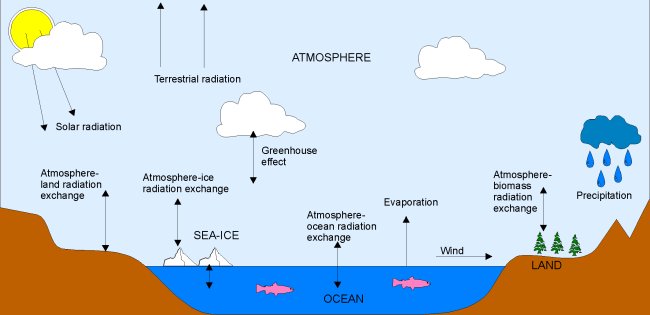Climate System
To understand climate change, it is important to first understand the meaning of climate and how it works. Climate is affected by the amount of energy the Earth receives from the Sun, as well as other flows of energy that takes place within the climate system itself. This system consists of the atmosphere, the oceans, the cryosphere (ice sheets) and biosphere (living organisms), as well as the geosphere (sediments and rocks). They affect the movement of heat around the Earth’s surface.
Atmosphere and Oceans
The atmosphere, consisting of different gases and aerosols, which is known collectively as air, is important in regulating Earth’s climate. Air is made up of 78% nitrogen and 21% oxygen. Greenhouse gases, although only a small portion of the atmosphere, have a great impact on the amount of energy that is stored within the atmosphere, and the Earth’s climate. These gases trap heat in the lower atmosphere, which is trying to escape into space, and because the heat remains in the lower atmosphere, this makes the surface of the earth warmer. This phenomenon is called the natural greenhouse effect, and it keeps the Earth about 33°C warmer than it would otherwise be. This phenomenon has been enhanced over the last 200 years due to man-made emissions. This is the main cause of global warming.
However, the atmosphere does not operate as an isolated system. The flows of energy takes place between the atmosphere as well as the other parts of the climate system, most notably the oceans of the world. For example, ocean currents transport the heat from warm equatorial latitudes to colder polar latitudes. Heat can also be transferred through water vapour. The water that evaporates from the surface of oceans stores heat, and this heat is subsequently released when the vapour condenses to form clouds and rain. The ocean is significant because they store a larger amount of heat than the atmosphere, and the top 200 meters of the world’s ocean store up to as much as 30 times more heat than the atmosphere. Therefore, the flows of energy that takes place between the oceans and the atmosphere has a huge impact on the global climate. Cryosphere (Ice sheets)
The cryosphere, which consists of the world’s ice sheets, glaciers and sea ice, has a significant impact on the Earth’s climate. This cryosphere includes the Artic Ocean, Greenland, Northern Canada, Northern Siberia, Antartica and most of the high mountain ranges throughout the world, where sub-zero temperatures persists throughout the year. Snow and ice, being white, reflects sunlight very well instead of absorbing it. Without the cryosphere, majority of the energy that we receive from the sun will be absorbed by the Earth’s surface rather than be reflected, and this will raise the temperature of the atmosphere.
Biosphere (Living organisms)
All land plants require carbon dioxide, water and the presence of sunlight to make food from photosynthesis. Through this process, carbon dioxide is used up and this will help to regulate the global climate. Microscopic planktons, found in the oceans, utilize carbon dioxide dissolved in the seawater to photosynthesize and create their tiny carbonate shells. The oceans will replace the carbon dioxide used by absorbing the gas from the atmosphere. When the planktons die, their carbonate shells will sink to the seafloor, which effectively locks away the carbon dioxide from the atmosphere. This system reduces the atmospheric concentration of carbon dioxide by at least four-fold, and this in turn significantly weakens the Earth’s natural greenhouse effect, reducing the Earth’s surface temperature.

This is how climate system work
|
